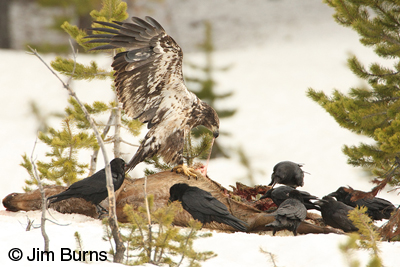
The eagle sweeps in out of the fog on outstretched wings, scattering ravens like shards of carbon across the snow covered knoll, landing atop the carcass where they have been feasting. The elk had been brought down by wolves shortly after daybreak, the ravens moving in after the canine predators had eaten their fill and retreated up the hill into the pines. Now the elk, this ex-elk, having given up its internal organs to its partners in the dance of life, lies on its side, bloody ribcage exposed to the avian scavengers, the second tier of nature’s undertakers.
Despite their iconic status as the symbol of our nation’s independence, Bald Eagles are scavengers. This one is an immature bird in second year plumage. It has not yet attained the species’ signature white head, though it already seems perfectly adapted to life in the wild as it stares down regally upon the rooks beneath it, daring them to supplant it from its throne upon the highest rib.
The massive beak, evolved for ripping fish scales, is signature enough, making the beak of its distant cousin, the Golden Eagle, appear almost dainty by comparison. Digging its talons securely into the carcass still damp from overnight frost and using its wings for balance, the eagle now deploys that beak, tearing muscle from bone and stripping entrails from the open body cavity.
The ravens, Common Ravens, perhaps a dozen strong and beside themselves with indignation, mill about the perimeter of red snow, snatching a bite here and there, constantly wary of the business end of this huge raptor nearly twice their size and four times their weight.. A bold one, perhaps the alpha raven if there is such a thing in the world of ravens, circles behind the eagle, grasps a tail feather in its beak, and tugs. Great wings flapping, the eagle turns and lunges at its tormentor. The undertakers fall back all around, squawking and cronking their protest, likely awakening the killers sleeping off their repast up in the timber.
By nightfall the carcass will be picked clean, reduced to bones and bits of fur. Nature is efficient and runs in rhythms no longer understood or often observed by our species. We are the poorer for this modern disconnect from our species’ roots. Tribes of the Great Plains did not bury their dead, but elevated them skyward on platforms of hides to await the work of ravens. They understood these ancient cycles of life and death, celebrated them, did not fear them.
If we as birders are to truly celebrate eagle and elk, raven and wolf, their beauty, power, and grace, and the adaptations which allow them to survive in nature, we must also accept and embrace red snow, white bones, black feathers, and, to quote Aldo Leopold, “the fierce green fire” in the eye of the wolf. Nature is not cruel. It is, to use an overworked post modern idiom, what it is. Birders stand upon the threshold of a doorway to our ancient past.